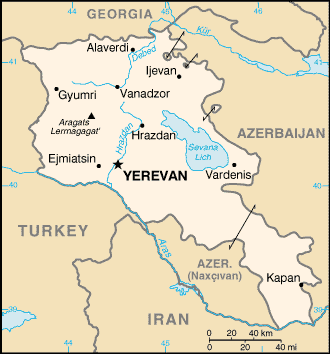Armenia
Map Courtesy CIA World Factbook |
The Republic of Armenia, or Armenia, is a landlocked country in southern Caucasus, between the Black Sea and the Caspian Sea, bordered by Turkey to the west, Georgia to the north, Azerbaijan in the east and Iran and the Naxçıvan exclave of Azerbaijan in the south. Armenia is a member of the Council of Europe and the Commonwealth of Independent States and for centuries has been on the crossroads between West and East.
Armenia was a regional empire with a rich culture in the years leading up to the 1st Century, spanning from the shores of the Black Sea to the Caspian Sea and the Mediterranean Sea during the rule of Tigranes the Great. In 301, Armenia was the first state to adopt Christianity as its official state religion, twelve years before Rome. There had been various pagan communities settlements before Christianity, but they were converted by the success of the Christian missionaries. It also changed between various dynasties. But after Parthian (Iranian), Roman, Arab, Mongol and Persian occupation, Armenia was substantially weakened. In 1454, the Ottoman Empire and Safavid Persia divided Armenia among themselves.
In 1813 and 1828, present-day Armenia (consisting of the Erivan and Karabakh khanates) was temporarily incorporated into the Russian Empire. After briefly existing as an independent state, in 1920 Armenia was incorporated into the USSR as the Armenian SSR.
During the final years of the Ottoman Empire (1915-1923), a great number of Armenians in eastern Anatolia (known to Armenians as Western Armenia) were killed in a series of events now known as the Armenian Genocide, officially recognized by some countries as the first genocide of the 20th Century. Between 1,000,000 and 1,500,000 Armenians died in the events. Despite the massive evidence to the contrary, the Turkish government continues to deny that these deaths resulted from mass deportation and eradication efforts by the Ottoman State, and therefore claims that they did not amount to 'genocide'. Instead, it maintains that they resulted from self-defense as most Armenians allied with Russia during the war, civil war, disease and famine, with casualties to both sides. The Armenian Genocide is recognized in numerous countries including France, Belgium, and Russia. Numerous US states have also recognized the killings as genocide. In a vain effort to further its cause Turkey has asked the Armenian government to create a commission to investigate both claims. The deaths are commemorated by Armenians worldwide on April 24th. On May 24 of the same year, the term "Crime against humanity" was used for the first time to describe what was happening then.
The Armenian diaspora strongly lobbies to draw parallels between the Armenian Genocide and the Jewish Holocaust which followed two decades later. One question often raised, is whether later genocides such as the Holocaust and those in Cambodia, Bosnia, Rwanda and Darfur (Sudan) and elsewhere, could have been prevented, or at least limited, had the Armenian Genocide been better recognized, at the time, and up to today.
Armenian leaders remain preoccupied by a long conflict with Azerbaijan over Nagorno-Karabakh, an Armenian-populated enclave that Stalin had placed in Soviet Azerbaijan. Armenia and Azerbaijan began fighting over the enclave in 1988 and the struggle escalated after both countries gained independence from the Soviet Union in 1991. By May 1994, when a cease-fire took hold, ethnic Armenian forces controlled not only Nagorno-Karabakh but also a large part of Azerbaijan proper. The economies of both sides have been hurt by their inability to make substantial progress toward a peaceful resolution and by mutual economic blockades.
The United States and allied military action in support of the opposition following the September 11, 2001 Terrorist Attacks forced the group's downfall. In late 2001, major leaders from the Afghan opposition groups and diaspora met in Bonn and agreed on a plan for the formulation of a new government structure that resulted in the inauguration of Hamid Karzai as Chairman of the Afghan Interim Authority (AIA) on December 2001. After a nationwide Loya Jirga in 2002, Karzai was elected President.
In addition to occasionally violent political jockeying and ongoing military action to root out remaining al-Qaida and Taliban elements, the country suffers from enormous poverty, rampant warlordism, a crumbling infrastructure, and widespread land mines.

